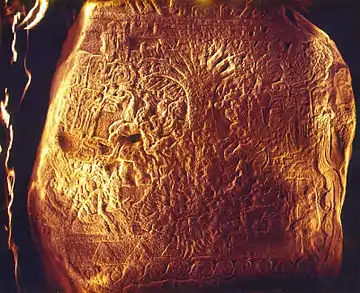Izapa Stela 5
Izapa Stela 5 is one of a number of large, carved stelae found in the ancient Mesoamerican site of Izapa, in the Soconusco region of Chiapas, Mexico along the present-day Guatemalan border. These stelae date from roughly 300 BCE to 50 or 100 BCE,[1] although some argue for dates as late as 250 CE.[2]


Also known as the "Tree of Life" stone,[3] it appears to illustrate a Mesoamerican creation myth.
The stela
Documented by Smithsonian archaeologist Matthew W. Stirling in 1941, Stela 5 is composed of volcanic andesite and weighs around one-and-a-half tons.[4] Stela 5 presents the most complex imagery of all the stelae at Izapa.[5] Researcher Garth Norman, for example, has counted "at least 12" human figures, a dozen animals, over 25 botanical or inanimate objects, and 9 stylized deity masks.
Like much of Izapan monumental sculpture, the subject matter of Stela 5 is considered mythological and religious in nature[6] and is executed with a stylized opulence. Given the multiple overlapping scenes, it appears to be a narrative.[7]
Interpretation
Mesoamerican researchers identify the central image as a Mesoamerican world tree, connecting the sky above and the water or underworld below.[8]
Linda Schele and Mary Ellen Miller further propose that the stela records a creation myth, with barely formed humans emerging from a hole drilled into the tree's left side. The associated seated figures are completing these humans in various ways.[9] Julia Guernsey Kappelman, on the other hand, suggests the seated figures are Izapa elites conducting ritual activities in a "quasi-historical scene", which is framed by, and placed in the context of, the "symbolic landscape of creation".[10]
Alternative interpretations
Based on parallels with traditions originating in the Old World, a few researchers have linked the stone to theories of pre-Columbian trans-oceanic contact. Mormon theorist M. Wells Jakeman proposed that the image was a representation of a tree of life vision found in the Book of Mormon.[11] Jakeman's theory was popular for a time among Mormons, but found little support from Mormon apologists.[12] Julia Guernsey wrote that Jakeman's research "belies an obvious religious agenda that ignored Izapa Stela 5's heritage".[13]
The carving was also proposed by pre-Columbian contact theorist Ivan van Sertima as supporting an African origin of the Olmecs.[14]
Notes
- Kubler, p. 328, or Pool, p. 273
- Guernsey Kappelman.
- Stirling; Christensen.
- Lowe at al., p. 110.
- Both Jacobs and Guernsey Kappelman state this, with others.
- Pool, p. 271.
- Kulbler, p. 328.
- See, for example, Guernsey Kappelman.
- Schele and Miller, p. 141.
- Guernsey, p. 124.
- Jakeman; Brewer, p. 12. Guernsey, p. 53, explicitly rejected this interpretation.
- Brewer (1999). Clark (1999).
- Guernsey (2006), p. 56.
- Van Sertima, pp.74, 101.
References
- Brewer, Stewart W., (1999); "The History of an Idea: The Scene on Stela 5 from Izapa, Mexico, as a Representation of Lehi's Vision of the Tree of Life", accessed June 2008.
- Christensen, Ross T., (1959) "The Symbol of the Tree of Life in Ancient America, and the New Tree-of-Life Carving Discovered at Izapa, Chiapas, Mexico," University Archaeological Society Newsletter 22 (1959): 4.
- Clark, John, (1999) " A New Artistic Rendering of Izapa Stela 5: A Step toward Improved Interpretation", Maxwell Institute, 1999. Pp. 22–33
- Guernsey, Julia (2006) Ritual and Power in Stone: The Performance of Rulership in Mesoamerican Izapan Style Art, University of Texas Press, Austin, Texas, ISBN 978-0-292-71323-9.
- Guernsey Kappelman, Julia; Izapa (Precolumbian Art and Art History)", accessed December 2007.
- Jacobs, James Q.; "The Izapa Ruins, A Photo Gallery", accessed December 2007.
- Jakeman, M. Wells (1953) "An Unusual Tree-of-Life Sculpture from Ancient Central America," in Bulletin of the [Brigham Young] University Archaeological Society vol 4: 26–49
- Jakeman, M. Wells, (1952) An Archaeological Reconnaissance of the Xicalango Area of Western Campeche, Mexico. Bulletin of the University. Archaeological Society, no. 3. Brigham Young University, Provo.
- Kubler, George (1990) The Art and Architecture of Ancient America, 3rd Edition, Yale University Press, ISBN 0-300-05325-8.
- Lowe, Gareth W. Thomas A. Lee Jr., and Eduardo Martinez Espinosa (1982) "Izapa: An Introduction to the Ruins and Monuments", in Papers of the New World Archaeological Foundation 31: 110.
- Norman, V. Garth, (1973) Izapa Sculpture, Part 1: Album. Papers of the New World Archaeological Foundation 30. Brigham Young University, Provo.
- Pool, Christopher (2007) Olmec Archaeology and Early Mesoamerica, Cambridge University Press, ISBN 978-0-521-78882-3.
- Schele, Linda; Mary Ellen Miller (1986). The Blood of Kings: Dynasty and Ritual in Maya Art. Fort Worth, Texas: Kimball Art Museum.
- Stirling, Matthew W., (1943) "Stone Monuments of Southern Mexico," Bureau of American Ethnology Bulletin 138.
- van Sertima, Ivan (1987). African Presence in Early America. Transaction Publishers. ISBN 978-0-88738-715-9.
External links
- Picture and drawing of the stone
- Stela 5 at the Archaeological Ruins of Izapa
- The History of an Idea: The Scene on Stela 5 from Izapa, Mexico, as a Representation of Lehi's Vision of the Tree of Life
- A New Artistic Rendering of Izapa Stela 5: A Step toward Improved Interpretation
- Mormon article containing a drawing of Stela 5
